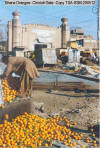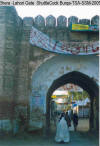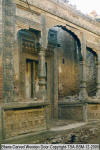|
|
the-south-asian.com January/February 2006 |
|
|||
|
Jan. /
Feb. 2006
Contents Real Issues Feature Health Heritage Art Lifestyle Books Between
Heaven and Hell
|
|
||||
|
Page 2 of 2
Bhera – The Town that Time forgot ……….. [ By Bherochi ]
Bhera: Town & People
Bhera is also home to an equally unique collection/ set of
ethnic groups/people callled Kukhran (also spelt Kukhrain) Khatris who are a
regional subcaste of Punjabi Khatris The Kukhran Khatris are a group of nine
clans (family names) who all originate from Bhera. Kukhrans were
traditionally warrior people who bore the brunt of Muslim invasions from the
northwest during the 12-16th centuries. Some converted to Sikhism during the
18th and 19th centuries. Common Kukhran names are Anand, Bhasin, Chadha,
Chandok, Kohli, Sabbarwal, Sahni, Sethi and Suri many of whom had migrated
from present Pakistan to India during partition. It is also home to Pirachas
and Elahis and the Hayats. Perhaps the name Pirachas is a variation of the
word Bherochis which was the name given to the residents of Bhera. The Prime
Minister of India, Dr. Manmohan Singh is a Kukhran of the Kohli subcaste. He
went to school at Gah a small village in Chakwal across the Jhelum river
about 40 miles from Bhera. Balraj Sahni ,perhaps one of the greatest Bollywood
film actors was also from Bhera . His niece Ms.Kalapana Sahni [a professor
of Russian Literature at JNU, Delhi] wrote a nostalgic travelogue in In her account of her trip to Bhera, she locates the Sahnian da Mohalla near the Railway Station. On the right side was the Municipality office, the Grain market was on the left of the Station. Sahnian da Mohalla was next to this area. Sheikh Hayat Akhter [now a retired Pakistan Customs officer in his 90s and living in Model Town extension ,Lahore ] corroborated this information. He is a friend of Baldev Raj Sahni and used to call him by the nickname Bally. He recalls that the Sahnis were one of the prominent families who had about 20 Marabas [1 Moraba = 25 acres] near the Railway Station and that the Sahnian da Mohalla had about 100 rooms and 10 bathrooms. Punjabi Khatris originated in the Pothwar plateau (Rawalpindi division) and surrounding regions of Punjab, Pakistan. When Pakistan and India gained independence, most of the Khatris in what became Pakistan migrated to India. Today Khatris live in all regions of India, but are concentrated in Punjab, Delhi and Uttar Pradesh. Prominent historical figures among the Khatris are all the Sikh Gurus (belonging to the Bedi, Trehan, Bhalla and Sodhi subcastes); Raja Todar Mal (a Tandon Khatri), who as Akbar's Revenue minister codified the revenue collection system; Hari Singh Nalwa (an Uppal Khatri), the prominent general under Maharaja Ranjit Singh [ Hari Singh Nalwa was so feared among the Pathans , that his name would be taken by mothers when scaring children into submission; the Diwans Sawan Mal & Mul Raj Chopra - governors of Multan under Ranjit Singh who instituted vast improvement in agriculture. During the Rajput Period (AD 647 to 1021) the Khatris lost political power to the emerging order of Rajputs. Unemployment caused them to switch their skills to commerce and trade. At the end of Rajput control, Khatris again reemerged as dominant. In the Muslim Period (AD 1021-1752) foreign Muslims from Central Asia, Iran or Arabia were employed in higher positions of bureaucracy and military. However, local administration and revenue collection remained in the hands of local Hindus or Muslims. Though members of other castes were also employed, most of these offices were held by Khatris. One of the offices held by Khatris was called "Qanungo", means "an expounder of law". This designation was used for hereditary registrar of landed property in a district. The founder of Sikhism Guru Nanak, a Khatri of Bedi section, started his career in one of these offices. Khatris continue to be the most educated group in modern Punjab. The Khatris were adversely impacted by the partition [1947] of India. It resulted in the loss of the traditional home regions of the Khatris. Although a large majority of Khatris are Hindus, some converted to Islam. The conversion started in 12th century and continued till 1947. In western districts of the Punjab (Sargodha, Mianwali, Multan, Jhang, Chakwal, Rawalpindi and Faislabad) converted Khatri traders called themselves "Khoja". Some time they are called "Khoja Sheikh". In other districts of the Punjab Khatris use "Sheikh" as title and it is generally assumed that they belong to Muslim trading families. The Khoja Sheikhs of Chiniot, a town of district Jhang, known as Chiniotis, are one of the leading industralists of Pakistan. A group of Muslim Khatris is known as "Qanungo Sheikhs", considered a higher caste. Many Muslim Khatris still use their pre Islamic Hindu gotras (sections). Most numereous gotras are Sahgal, Chadha, Wohra, Sethi, Magun, Kapur, Duggal, Ror, Gorawala, Mehendru, Puri, Topra, Churra, Talwar. An important citizen of Bhera (bom 25 Dec. 1850) , Bakshi Ram Dass Chibber, was a classic and a majestic Mohyal patriarch. Popularly known as Munshi Ram Dass. he was a tutor of Urdu and Persian to the ruling British. Amongst his pupils were such formidable personalities as Lord and Lady Minto. Lord and Lady Hardinge, Lady Curzon, Lady Lansdowne and Field Marshal Roberts, the Commander in-Chief of India. He used his influence to get the Mohyals listed as agriculturists. On the request of Bakshi R.D. Chibber, Russell Stracey wrote the History of the Mohyals in 1911, which till now is considered to be the most reliable account of the venerable community. Bakshi Ram Dass was a philanthropist who gave Rs. 30,000 to DA V College Lahore and Rs. 20,000 to the General Mohyal Sabha in pre-1947. The Ram Dass Block was built with his contribution in the Mohyal Ashram of Lahore. [source www.Mohyal.com ]. The Mohyal clan consists of the family names BALIS, BHIMWALS, CHIBBERS, DATTS, LAUS, MOHANS and VAIDS’s. Cerain titles were bestowed on them by the Moghul and Sikh rulers for their outstanding work. These include: Bakshi, Bhai, Chaudhri, Dewan, Malik, Mehta, Rai and Raizada . Six castes which embraced Islam due to the pressures of time were : Hussaini Brahmin, Gakhar, Khakhe, Bombe, Lange and Lohana. The last two are believed to have descended from the Laus. Gakhars, the fierce fighters of Pothar, were a sect of the Hussaini Brahmins. Some of the Mohyal clans still have the amber colored eyes and blond hair that give away their central Asian origins. Dera Bakhshian in the Rawalpindi district produced leaders for the Mohyal clan such as Bakshi Jawahar Mal Vaid, a governor in the Sikh period [ 1790-1850] , Risaldar Major Bakshi Prem Singh Vaid (1822-1892), Sardar Bahadur OBI, O.M.who in an army career of 36 years, was awarded 22 squares of land at Sangla Hill, Skeikhupura. He played a prominent part in the siege of Delhi in 1857. His son, Risaldar Major Hony. Captain Tirath Ram Vaid, 1857-1924, O.B.I., O.B:E, Sardar Bahadur presided over the Mohyal Conference held in Rawalpindi in 1919 and was the recipient of 9 squares of land which was consolidated at Sangla Hill [ next to Nankana Sahib ] and renamed Prem Kot, after his illustrious father. Bollywood actors Sunil Dutt and his son Sanjay Dutt are also Mohyals, and so is the film director J.P. Dutta. A chieftain named Datt apparently accompanied Alexander the Great on his return journey to Macedonia, as an envoy of Raja Porus. When Alexander fell ill and died at Babylon, Datt along with his followers drifted to Arabia and settled at Harya Bunder. They apparently assisted the holy prophet Mohammed in his travails and there emerged a viable community of Datts in Arabia. Bhera – Town architecture, crafts, products.
Some of the carved wooden doors in Bhera are now in the Lahore Museum. The carving is both floral and geometric. The wooden balconies or "Jharokas" too are a sight to behold. The design proportion of the houses, the symmetry of the design is obvious in these photographs. The Sikh Gurudwara is a beautiful, quasi-Italian structure. From its magnificent column, one can see the hills of the Salt Range and the surrounding country side with its mustard fields and orange and kinnow mandarin orchards. The eight gates are still there. The names are Lahori, Lal Gate , Multani Gate, Piranwala Gate , Chinioti Gate and were probably rebuilt around 1865 by the British . The Sher Shah Suri "Jamia Bugvia" Mosque [1540] still functions with its beautiful floral roof frescoes. A crumbling police station built in 1870 still stands as a mute witness to the ravages this town has suffered . Its famous coloured handloom cotton "Khes" [ heavy bed covers] are now defunct. Its henna is till famous and is sold to all parts of Pakistan. Also famous are its "Warian" [ dried & spiced Lentil balls ] . So too is the sweet made from "Channas/Basin" [grams] called "Patisa". Still in production are the wooden tops or Lattoos . So too are its lac coloured wooden bed posts. Its inlaid work is also famous - used in walking stick handles. Also famous are its Loquat trees which grew in abundance in Pind Dadan Khan across the Jhelum river. In the old days there was a "Kanjirian da Mela" [Festival of the Courtesans] there. The Railway Station had a circular turn around for its engines. We shall try to see if it is still there. In a future article "Bhera -Part 2 " a detailed map of Bhera will be presented with the walled and Gated town marked by its well known Mohallas and buildings mentioned here. [See also this link created by Mr.H.A. Bhugvi who is also an amateur Ham radio enthusiast http://www.geocities.com/hbugvi/ ] *****
|
|||||
|
Copyright © 2000 - 2006 [the-south-asian.com]. Intellectual Property. All rights reserved. |
|||||




